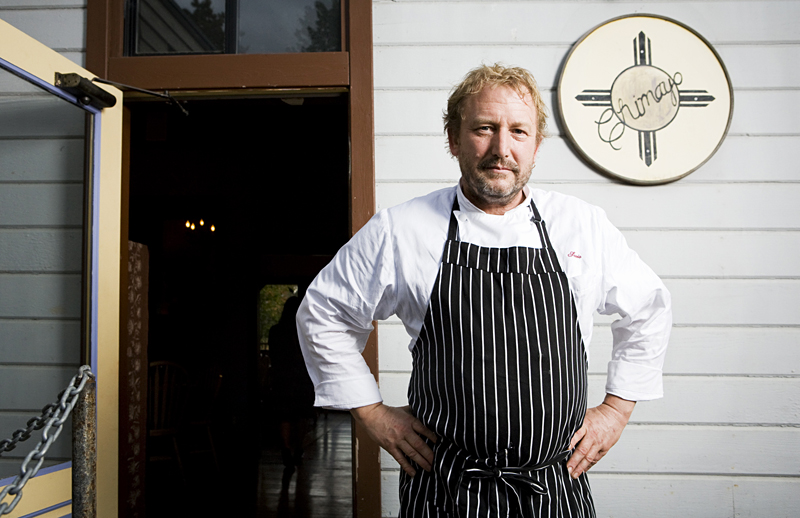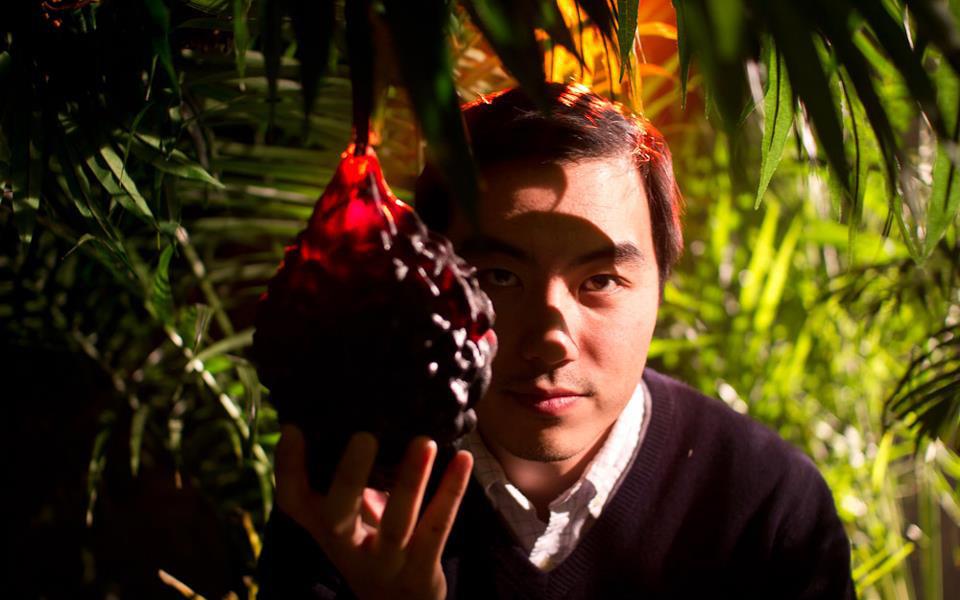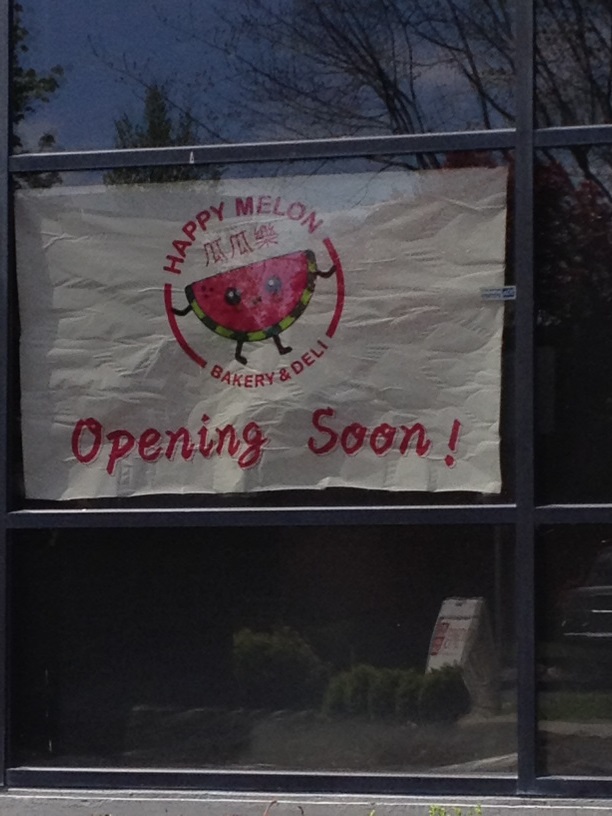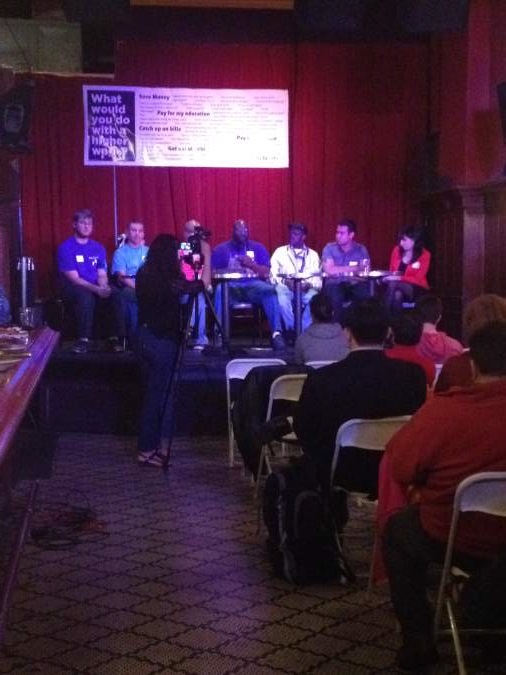The restaurant-soon-to-be-formerly-known-as-Chimayo takes its clientele from Tex-Mex to Tuscany.
“We’re kind of hard to find,” confesses Bill Patterson, the pasta virtuoso who offers nightly recitals on Orcas Island at his restaurant, Chimayo.
Patterson is given to understatement— he believes the communion of eater and Dungeness crab shouldn’t be interrupted by anything other than butter—and his assessment represents the square root of the situation. His restaurant is maddeningly hard to find, in this world and its virtual equivalent. There’s no website for the restaurant, tucked into the rear corner of a shabby indoor arcade that houses a consignment clothing shop and a realtor’s office, nor is there any sort of signage that would magnetize a diner craving lardo and guanciale. A shingle hung above Eastsound’s Main Street boardwalk points to Chimayo, a name Patterson kept when he bought the 9-year-old New Mexican restaurant from local restaurateur Karen Campbell in 2010.
Patterson didn’t hang onto only the name. He kept the menu intact, continuing to sling the tortillas, chiles, and beans that had acquired a following he was loath to unsettle during a fierce recession. “When you know 90 percent of the people who walk in the door, it’s hard to look them in the eye and say they can’t have what they want,” Patterson says. “It would be perverse.”
A former caterer who’d dabbled in pop-up Sunday suppers for islanders long before such arrangements were trendy, Patterson had watched five local restaurants succumb to the flailing economy. If he could ride a plate of enchuritos through the financial squall, he fully intended to do so.
But, after six months, Patterson was struggling to repress his culinary inclinations. So he started sneaking Italian dishes onto the dinner menu. The unexpected appearance of linguine and risotto baffled tourists, who weren’t sure how to reconcile the fancy-sounding dishes with their quesadillas. Among locals, though, Patterson’s affinity for Mediterranean cookery was well-known. They cheered the restaurant’s clandestine transition from Chimayo to Chianti.
Diners who Patterson describes as “well-heeled and well-traveled” were ecstatic to discover the island’s best pasta in a New Mexican restaurant. The specter of cognitive dissonance didn’t stop them from running up guest checks that put Chimayo on track to replicate its 2008 sales figures. “The Italian stuff is outselling the Tex-Mex menu eight to one,” reports a grateful Patterson, who realized he’d never get rich selling $8 sandwiches. (A plate of scallops at the reimagined Chimayo runs $24.)
Still, he refuses to rush the evolution. Patterson standardized the Italian format last fall, but the dinner menu’s back side still lists a number of “Chimayo favorites.” Patterson says he plans to dispense with the bi-cuisine menu within weeks, but as recently as last month it wasn’t unusual for Chimayo guests to encounter fellow diners happily gobbling chiles rellenos with Vivaldi playing in the background. The “Chimayo favorites” will still be served at lunch, but Patterson is edging toward a name change. “I don’t know if I want to address that publicly,” he says, hinting he might retire “Chimayo” before year’s end.
“People expected it to change overnight, but you need to move slowly in a small town,” Patterson explains. “Everything I’ve done so far I’ve done slowly.”
By the time you read this review, Patterson may have rechristened the restaurant, which is bound to make it even harder to find. Consider the aggravation a side effect of being sucked into a brilliant chef’s vortex. The eccentricities that surround Chimayo are secondary to the splendid pasta the restaurant produces. And while pasta is the showstopper, I didn’t find a single dish at Chimayo that would make a Seattleite regret the ferry ride.
Chimayo doesn’t have an especially distinguished-looking dining room. With its bare, white oak–hued tables and arbitrary wall hangings, the sunny space could double as a suburban home’s breakfast nook or a burrito joint. There’s space for only a few dozen diners, and the restaurant had nowhere to seat us when we arrived for our reservation. Realizing the carpeted hallway on the opposite side of the restaurant’s closed front door was an unsuitable waiting area, the hostess suggested a glass of wine on the patio, a lovely terrace that spent much of the chilly summer unoccupied. When I didn’t immediately settle on a varietal, the staffer warmly offered to pour a sample of any of the four available reds.
Patterson’s menu is dominated by local products, including the Dungeness crab that’s the centerpiece of the restaurant’s most popular appetizer. “I’ll be perfectly honest,” Patterson says of his shaggy, crimped cushions of crab ravioli, which are frequently wiped off the specials chalkboard before 7 p.m. “It’s a shameless ploy to get tourists into the restaurant.”
Crab is a headache for Patterson, who can almost hear the shellfish’s freshness ticking down: “It has to be iced, it has to stay on ice, and you’ve really only got about 48 hours to use it. I don’t care what the package says.” His urgency to rid the kitchen of crab before it goes bad might account for the abundant portions of meat he encases in each delicate raviolo. Confronted with so much deep-seated sweetness, eaters are unlikely to question Patterson’s motivations. They’ll be too busy savoring the dish’s oceanic flavors and fighting over the third raviolo, finished with bloated sun-dried tomatoes, effervescent leaves of basil, and enough butter to coat the bottom of the shallow serving bowl.
It’s always wise to gravitate toward pasta at Chimayo, but there are respectable consolation prizes for diners who miss out on the crab ravioli. A pristine Caesar, dressed in a hand-me-down coat of lime juice and serrano peppers inherited from Chimayo’s first owner, is as perky as a party host. A ragtag bowl of steamed mussels, ringlets of purple onions, red peppers, and squash suffered from an overwhelming garnish of bitter parsley, but the broth buried underneath the bivalves was terrific.
If asked, Chimayo’s kitchen will downsize its pastas so you can progress through the menu in true Italian style, climaxing with chicken cacciatore or eggplant involtini. A dusky lamb ragù, made from a leg of lamb that slurped up red wine during braising, is heaped on a hillock of luxuriantly creamy risotto. But the satisfying dish isn’t all darkness and heft: It’s topped with a few leaves of young butter lettuce and grilled stretches of zucchini.
Patterson makes his pasta from flour and eggs—no water, no oil, no salt. He uses European double-zero flour, a designation assigned to soft red-wheat flour ground fine as silt, even though he has to schlep all the way to Seattle to buy it. The eggs come from an off-grid Orcas Island flower farm where “the chickens eat worms and bugs. They’re the finest chickens.” (I promised Patterson I wouldn’t reveal the farm’s name, since he’s terrified his source of eggs could dry up.)
The pastas are paired with sauces and proteins according to the seasons and Patterson’s whims. The rich noodles are drenched in a robust tomato sauce and strewn with sausage made from Patterson’s Mangalitsa pigs, draped in pesto, coddled with cream, and wound up with shellfish. Chewy, nutty pappardelle, trimmed into ribbons as jagged as the stripe on Charlie Brown’s shirt, arrived in a puddle of cream, dotted with crisp green peas and unapologetically porky bits of prosciutto. However presented, the pasta is ethereal.
Dishes which made Patterson weep on a recent trip to Italy are the inspiration for his noodling. “It was a life-altering experience,” Patterson says. “We just ate every day. We stayed north of Florence for three weeks. We never set foot in Florence. Everything we wanted to see was off the beaten track. We ate in these towns that didn’t have bus routes.”
On Orcas Island, Patterson has created a restaurant much like the unassuming farmhouse eateries he so admires. But in addition to coming up with a new name for his restaurant, he still has much to do. “In my perfect world, we do simple, coursed meals. We’re serving family-style. Next summer, we hope to put in a wood-burning oven, so maybe we’re roasting game birds, we’re roasting mussels. And I’m applying for my license to make limoncello. It’s a fantastic way to end a meal.”
Patterson may be fashioning finales, but no liqueur will make the arrival of a Chimayo meal’s conclusion any less poignant. Diners may very well find themselves strolling a bit slower on their way out of the restaurant, scanning summer cottage pictures in the neighboring real-estate office’s window, looking for a mortgaged excuse to spend more time in this magical Orcas Island hideaway.
Price Guide
Mussels $14
Crab ravioli $14
Linguine $22
Pappardelle $20
Lamb $24








